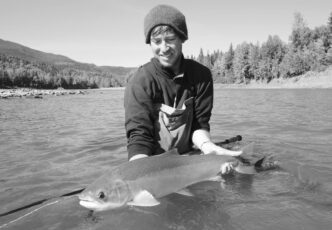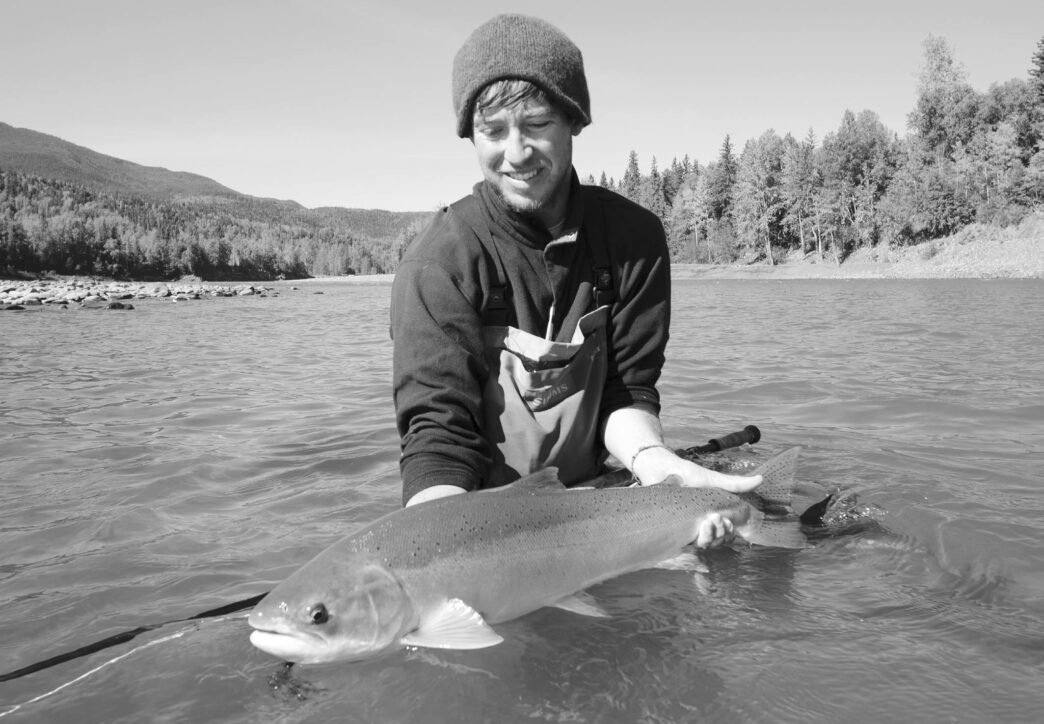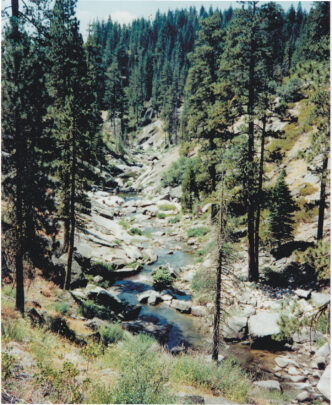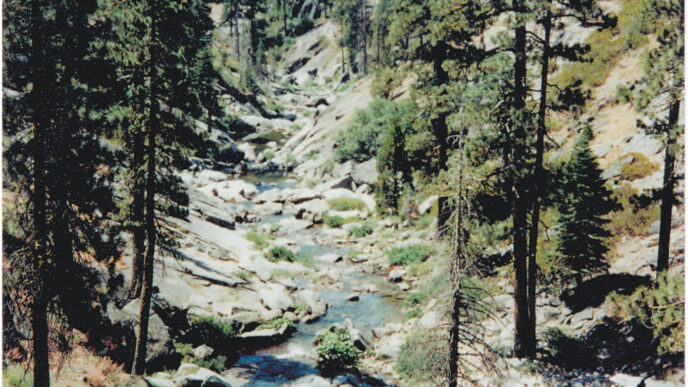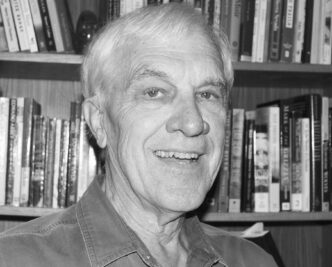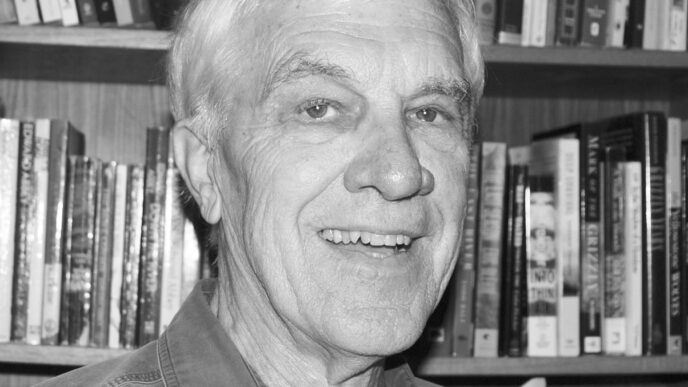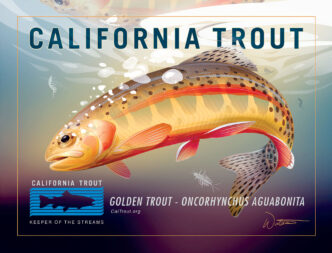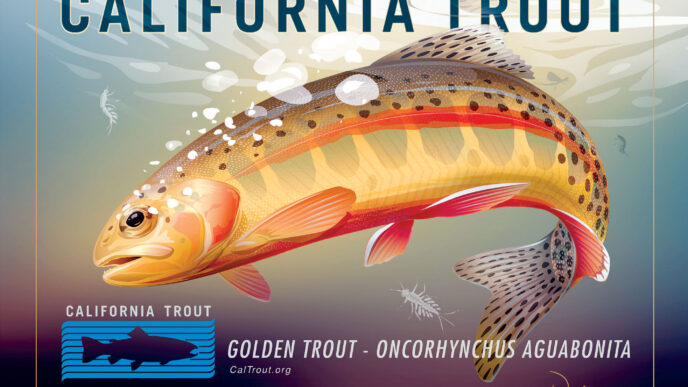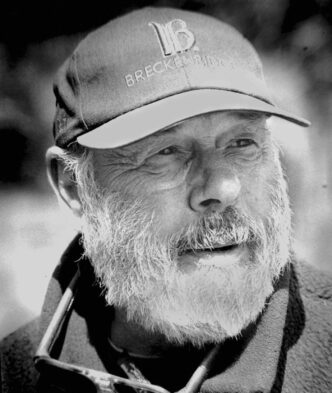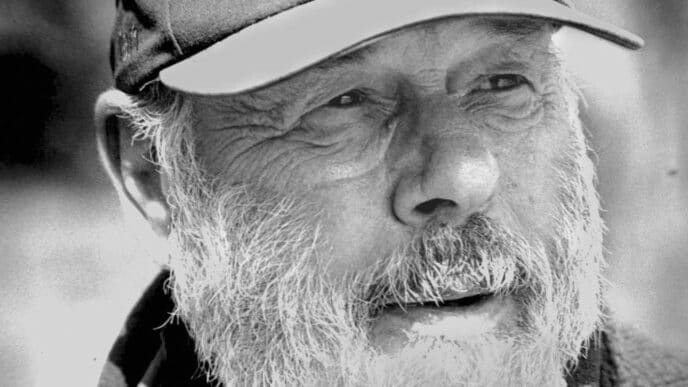At 22, Loren Elliott has achieved what some folks aspire to and never accomplish in a lifetime. A licensed guide who initiates fly fishers into the mysteries and pleasures of fishing the surf zone of the Northern California coast, he’s also a published angling writer and photographer whose work has appeared in this magazine, Fly Fishing Salt Waters, Fly Fisherman, The Drake, American Angler, Fly Tyer, and Northwest Fly Fishing. Check out his Web sites at www.LorenElliottFlyFishing.com and soon-to-be-live www.LorenElliottPhoto.com. He has also appeared in a few of Mikey Wier’s videos, such as Soulfish. If angling were baseball, Elliott would be a top draft pick. We’re fortunate that he already plays on our team.
Bud: You’ve been fly fishing since your age was in the high single digits and fishing the surf since it was in the low double figures. And pretty much since the time when you could have a job, you’ve been involved in the business of fly fishing. How did that happen? What does a kid find in fly fishing that inspires that kind of passion — and how do we make that sense of things available to other kids?
Loren: My parents always felt that spending time outdoors was a really important part of my upbringing. It was never really about the fishing, but more about spending time together in nature. It was the fly fishing, though, that really connected me to my surroundings and gave the health of the rivers we visited a deeper importance. A passion for exploring new places with a fly rod in hand grew from those early years. I was hooked by the excitement of seeing a big trout sip a dry or feeling a hard tug while streamer fishing, and I haven’t found many other experiences that provide an equal rush. I have also always been attracted to the remoteness of the locales I find myself in when fishing.
Living in San Rafael, I frequented the now gone Western Sport Shop. There I met mentors like John Quigley and soon was offered a job. Working in the fly department during high school, I began giving casting lessons and putting on clinics, which led to the genesis of my seasonal guide service. I ran my guide business each summer when I would come back to the Bay Area from college in Seattle, and am now still guiding during the summer months post-college.
Getting kids interested in fly fishing is a tough one. During my teen years, I met extremely few peers who were passionate about it. Now, in my early twenties, I have befriended a handful of anglers around my age, but still, most of my fishing buddies are a good bit older than I am. When I guide or give casting lessons to youngsters, they are almost always enthusiastic about the experience. The conundrum is why it doesn’t stick and develop into something more. I don’t yet have a good answer as to why this is, but it is something I think about often.
Bud: As a guide, you’ve been specializing in surf fishing in Northern California, targeting stripers and other big fish. I once took a friend from Southern California — an accomplished surf-zone fly fisher — surfperching along the San Mateo coast, and the first thing he said was, “You fish in that?” What brought you to the Northern California surf zone, and how did you learn to fish that turbulent environment for those species?
Loren: After my start in trout fishing, I was introduced to saltwater fly fishing in Mexico and Belize. As soon as I caught my first bonefish, I realized I had finally seen the light — that there is something undeniably special about the salt. Looking for ways to extend this excitement to my local waters, I stumbled across reports from now good friend Mark Won, who was experiencing phenomenal fishing for surfperch and striped bass in the Bay Area surf around 2006. I contacted Mark, and he was generous enough to invite me to fish with him. That was the start of my passion for the NorCal surf, as well as my friendship with Mark, who has passed on an incredible amount of hard-earned knowledge over the years. I later befriended another California surf veteran, Dave Sellers, and combined what I learned from these two fishermen with many hours spent on the water to figure out this fishery.
The Northern California surf is definitely the most unforgiving fishery I have ever experienced. That is really part of its appeal for me. Though I was able to get into surfperch pretty quickly, it took me multiple seasons to get my first striper on the fly in the suds. After that first fish, there was no going back. I still have yet to find many thrills as great as standing in cold, breaking waves a few miles from the Golden Gate, watching backing pour off your reel as a monster bass heads through the surf break. Now being the only guide specializing in this fishery, it has been a rewarding experience to see other anglers hook their first perch or striper.
Bud: You’ve achieved a lot on the business side of fly fishing, but at your age, the future is still wide open. Granted that life takes strange turns, let me ask you a kinder version of that awful job interview question, “Where do you see yourself in five years?”: What kinds of different futures (plural) do you envision for yourself?
Loren: That is exactly the question I have been wrestling with of late. I take consolation in knowing there are a lot of directions in which I could head, but I am still very unsure of which will be the right fit. I majored in environmental studies, and there are a number of environmentally related career options I could follow. While receiving that degree, however, my passion for photography and journalism took off, and so I am now seriously considering pursuing a career in photojournalism, as well. In either case, I would likely benefit from going back to school in the near future to get a master’s degree. I’ll be moving to the East Coast in the fall, and I will be looking at universities back there. One thing for sure, though, is that I plan to always be involved in the fly-fishing community as a writer and photographer. I don’t know if I will be guiding the surf five years from now, but I hope to continue teaching fellow anglers about this fishery for the next few summers.
Bud: You’ve already well into a successful career as an angling writer and photographer. What was your apprenticeship as a writer? What did you read, and how did you develop your talent over time to become publishable?
Loren: My passions for writing and photography really took hold in high school. I was fortunate to take film and digital photography classes, as well as creative writing courses. After each assignment, I felt proud of my work and had a desire to improve. This was far from my feelings about math and chemistry classes, which I dreaded beforehand and did my best to forget afterward. I tried to push myself as a writer and photographer in college and found that doing both for the university newspaper was one of the most rewarding experiences I had during school. I find writing and photography to be equally demanding, and both challenge me to no end, but in the best possible way. I know that I certainly wouldn’t be where I am now without the guidance of some great teachers and professors in high school and college. My goal is for my writing and photography skills to improve as much in the next eight years as they have in the last eight years. These are pursuits at which one can always become better.
As for literary influences, I have had many, but the author that stands out is Russell Chatham. Of course I read plenty of work completely unrelated to fishing, but we all appreciate a great fishing story, and Chatham’s Dark Waters and An Angler’s Coast are great examples of phenomenal writing that transcends fishing and accomplishes something much deeper than recounting a fish tale.
Bud: Photography is a total mystery to me, because there’s this mysterious black box involved. (I’m a point-and-shoot photographer for life.) How have you learned photography, and how can anyone (even me) make progress as a photographer?
Loren: My photo roots are in the darkroom, developing film. Although I am confident I will never touch a film camera again in my life, I think that starting out with film gave me a foundation that has made me a better digital photographer. I later took digital photography classes and haven’t looked back. I used to shoot only photos of landscapes, fishing trips, and other nature-related subjects. Though I really enjoyed this, my prowess as a photographer didn’t make any big leaps until I became a staff photographer for my college’s newspaper. Shooting true journalism got me out of my comfort zone and pushed me to become an all-around better shooter. This instilled in me a love of photojournalism, while also making me a much better nature and travel photographer. I’ve now been out of school for a while, but regularly shoot concerts for a music-review Web site and have no plans to get out of the photojournalism arena.
When it comes to novices making the first steps to improving as a photographer, the initial step is to get a camera that allows the user a lot of control and then switching that dial away from Auto mode. This doesn’t mean having to commit to a digital single-lens reflex camera, because there are many very capable compacts that allow a great degree of user control and produce high-quality images. As soon as you are out of Auto, you will have to start reading and learning about what goes into creating a technically and compositionally pleasing image. Thinking out each shot before touching the shutter release and executing the proper settings and technique with an affordable compact will create more appealing photos than even the most expensive DSLR will take in Auto mode.
Bud: When I interview folks who have been around California fly fishing for significant fractions of a century, I often ask them how things have changed. I realize that fly-fishing the surf zone, in particular, is new enough that it’s silly to speak about its “traditions,” but I’m interested in your relation to fly-fishing tradition in general. Looking in the rear-view mirror, what do you do differently from those who came before you, and how do you place yourself in the tradition of fly fishing (and angling writers), all the way back through Theodore Gordon and Halford and Skues to Dame Juliana Berners?
Loren: There is no doubting that many noted California anglers that came before me made what I do possible, in terms of both fishing and writing. Without the likes of Russ Chatham, Dan Blanton, Ken Hanley, Jay Murakoshi, and many others, I am not sure where fly fishing in this state would be today. I appreciate their efforts and achievements because of what they have allowed me to do. These guys pioneered fisheries and popularized many of the methods that I use today.
In the twenty-first century, there really aren’t any more fisheries in this state to be pioneered. Most everything that could be done with a fly rod has already been accomplished by someone already. I see my role as one centered on environmental stewardship and conservation. Priceless ecosystems such as our steelhead rivers, the amazing California Delta, and the San Francisco Bay are quickly approaching a tipping point. As anglers, we don’t want to experience the grim reality that could be much closer than most realize if action is not taken to protect these invaluable places. If people don’t understand how much better these fisheries were 25 years ago and how devastated they could end up 25 years from now, their deterioration will continue. I fear a day when I will have kids and won’t be able to take them fishing for steelhead in the Eel River or stripers in the Delta. Because of this, I intend to use my writing and photography as avenues for publicizing conservation issues that dearly need to be addressed.
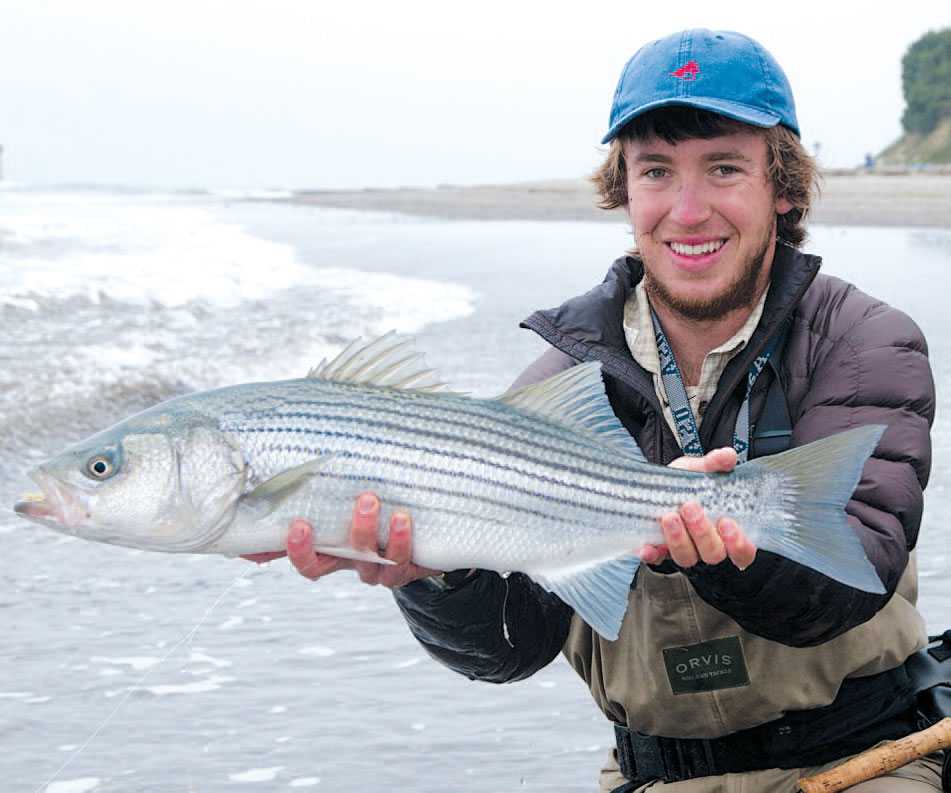
Bud: You grew up in west Marin, a special place in the Bay Area for many reasons, but one of them involves the work of another kid from Marin who ended up writing about fly fishing, Russell Chatham — you’ve already mentioned his influence. In the September/October 2012 issue of California Fly Fisher, we published “A Set of Tides,” his recollection of fishing Papermill Creek there for steelhead in the late 1950s. You’ve become a gonzo steelheader yourself, but have had to go a long way to the north to find them. And you now have a degree in environmental studies — something that didn’t even exist in Chatham’s early years. Chatham has written movingly about steelhead fly fishing in the West. How does a writer and photographer go about representing steelhead fly fishing and steelhead habitat today?
Loren: Becoming a passionate steelhead fisherman quickly got me involved with steelhead conservation. I was lucky to work with the Wild Steelhead Coalition out of Seattle, and that experience has given me a deeper understanding of just how dismal steelhead runs are up and down the West Coast compared with Russ Chatham’s days of fishing Papermill Creek. I have found that there are many other anglers who, like me, weren’t around in the good years and never saw the declines that have happened from California through British Columbia. Many of these anglers, through no real fault of their own, are ignorant of the history of our steelhead and how much of a shadow the populations are of their former selves. Understanding just how much better the runs were 50 years ago compared with today, from Papermill to the Skagit and beyond, is critical to grasping just how badly humans have messed up and just how impressive the potential for these fish is.
As a result, I make a very conscious effort to not glorify the steelhead angling I do, but instead to ground it in the history of the rivers I love and the conservation efforts that are critical to their health. Education is the most important part of this puzzle, and I do my best to be a part of that, from the way I address steelhead conservation in my writing to the example I set in handling wild steelhead in the photos I publish.
As a side note, I was lucky enough to fish with Russ Chatham a few years ago and can attest that he is the real deal. It was a thrill to watch him cast his fiberglass rod so effortlessly.
Bud: You fish the surf zone and also for the lordly steelhead. But do you still fish for just plain old trout? And what about other species?
Loren: Although I spend the majority of my fishing days in pursuit of steelhead and striped bass, my roots are definitely in trout fishing. The wild rainbow, brown, and brook trout of California’s mountains were what originally hooked me on this lifelong passion, and I still enjoy the occasional trip back to the Sierra to chase them.
What really gets me going, though, is traveling to tropical destinations to chase saltwater species that I can only dream about in California. I have been lucky to fish for roosterfish, snook, bonefish, permit, tarpon, redfish, and many others that I find every bit as thrilling as my beloved striped bass and steelhead. I am actually heading down to Baja to fish for roosters, snook, and corvinas in a few weeks, and then I hope to start planning a trip to the South Pacific for monster bonefish.
Bud: You’ve said that you’re planning to move to Boston. What does Boston have that San Francisco does not? What will you be doing, and where can we look for your work in the future?
Loren: I am moving to the Boston area at the end of my guide season in late August and getting very excited about the fall striper run back there. Comparing San Francisco and Boston is akin to a comparison between steelhead and stripers… they are both about as good as it gets, and it would be impossible for me to say one is better than the other. I’ve grown to love San Francisco and Seattle, but feel a strong urge to explore and experience a different part of the country while I am young and can pick up and move easily. I will be spending lots of time chasing striped bass on the eastern seaboard and figuring out my life’s next steps. I hope to return to California for the summer months in 2014 to guide the beaches again and take advantage of all that I miss so much about the Bay Area each time I leave.
Bud: Here we are at the obligatory Silly Tree Question. I first asked it of Ken Hanley, so consider this a form of dharma transmission between surf-zone anglers. If you were a tree, what kind of a tree would you be?
Loren: That’s a toughie. I’d probably have to go with one of California’s redwoods, because they seem to get hugged by a lot of cute female tourists who travel a long way just to have their picture taken with them.



